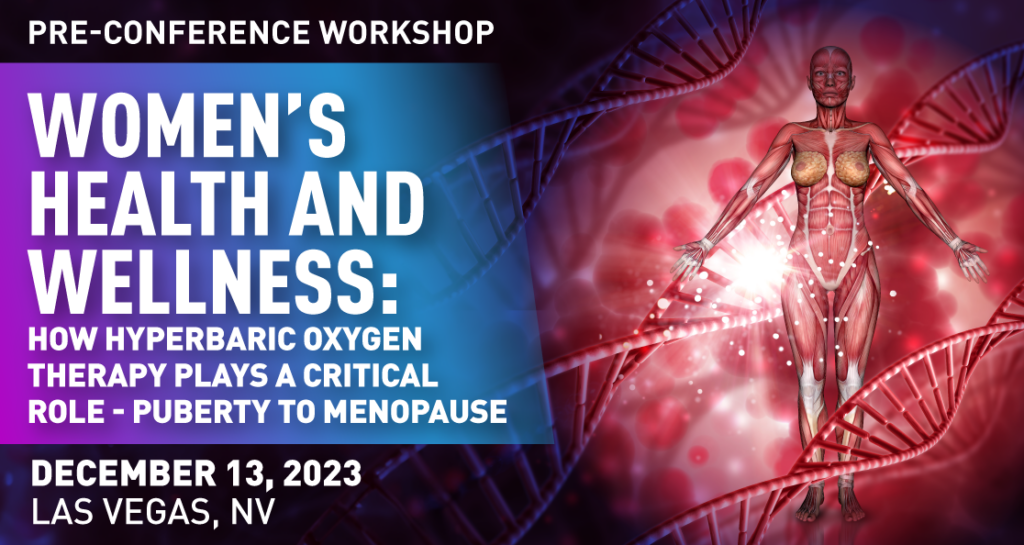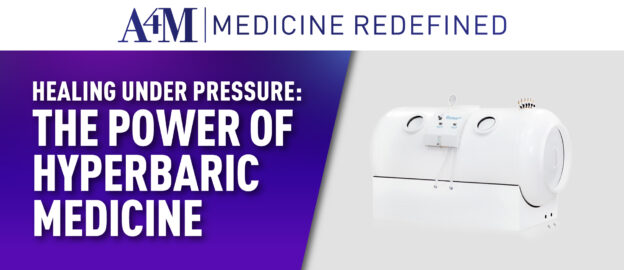Hyperbaric oxygen therapy (HBOT) stands at the forefront of functional, anti-aging medical innovation. Originally used to treat conditions such as carbon monoxide poisoning and air or gas embolism, this modality is now emerging as a promising therapeutic option for a wide variety of health conditions. HBOT’s versatility makes it ideal for tailored protocols based on a patient’s unique needs — especially beneficial for women who have evolving healthcare priorities across their lifespans.
By leveraging oxygen’s restorative properties to offer drug-free healing, HBOT activates regenerative physiological processes that optimize female health and well-being. Specific applications currently under investigation include supporting hormonal balance, reproductive health, and weight management, among many other potential uses. HBOT protocols are also being developed to target autoimmune disorders, metabolic conditions, and age-related decline in women.
With its ability to stimulate the body’s innate healing capacities, HBOT represents the future of functional medicine – harnessing natural healing pathways through the power of oxygen to meet women’s health needs throughout all stages of life.
How Does Hyperbaric Oxygen Therapy (HBOT) Work?
During treatment, patients are exposed to 100% oxygen in a sealed chamber under increased atmospheric pressure. This process, referred to as “hyperoxia,” dramatically increases the amount of oxygen transported in the blood, allowing the body to absorb oxygen levels up to 15 times higher than at normal pressure. The oxygen-rich blood circulates throughout the body, nourishing tissues that have been starved of oxygen and stimulating the growth of new blood vessels.
HBOT revitalizes damaged tissues in several vital ways. It reduces swelling and inflammation, fights infection, neutralizes toxic byproducts of injury, and ramps collagen production and other healing processes. To promote new skin cell formation and stimulate collagen, HBOT encourages the production of new blood vessels and vascular endothelial growth factors. The therapy also blocks the action of harmful bacteria and works to strengthen immunity; it can incapacitate toxins and improve the ability of white blood cells to combat invaders.
Clinical Applications
With HBOT, more oxygen reaches compromised tissues, fueling the regeneration of damaged areas. As a result, this therapy is indicated for treating certain injury-related conditions like chronic wounds, burns, and acute trauma. The FDA approves the use of HBOT for gas or air embolism, gangrene, carbon monoxide poisoning, chronic refractory osteomyelitis, decompression sickness, and gangrene trauma. However, emerging research shows great promise for an expanded range of the therapy’s uses, particularly women’s health applications that are currently under investigation, and suggests integrating HBOT into treatment plans for various women’s health conditions may open new doors for healing.
The Wide-Ranging Healing Properties of HBOT
With the proper dose, HBOT can have powerful healing properties, Dr. Renie Guilloid, director of the Hyperbaric Medicine Program at the Institute for Exercise and Environmental Medicine, told Forbes. According to Dr. Guilloid, inducing a controlled amount of oxidative stress by producing free radicals in the blood and tissues activates several beneficial cellular processes and pathways. Some of these include:
- Assisted development of new blood vessels, improved microcirculation
- Increased number and activity of stem cells
- Improved collagen production
- Inflammation modulation and swelling reduction
- Reduced fibrosis in irradiated tissues and areas with multiple surgeries
- Ischemia and reperfusion injury prevention
- Accelerated healing of infections
- Air or gas bubble dissolution in blood vessels or tissues
However, the beneficial effects of HBOT depend on how the treatment is performed and the unique needs of the patients.
HBOT and Its Role in Women’s Health
From addressing age-related concerns to supporting fertility and reproductive well-being, HBOT is proving to be a versatile and transformative therapy for women at every stage of life. Some exciting applications of HBOT currently under investigation for women’s care include harnessing oxygen’s rejuvenating effects for supporting cognitive function, balancing hormones and alleviating menopausal symptoms, boosting weight loss results, and facilitating healthy aging.
Anti-Aging Benefits and Healthy Aging Support
Emerging research indicates hyperbaric oxygen therapy (HBOT) may slow aging processes, prevent age-related diseases, and promote longevity. HBOT enhances angiogenesis, reduces inflammation, and boosts antioxidant defenses – all mechanisms involved in healthy aging.
A study published in Redox Biology examined the mechanisms underlying the anti-aging effects of hyperbaric oxygen therapy at a cellular level. HBOT was found to suppress cellular senescence, which leads to the accumulation of senescent cells that secrete inflammatory cytokines and can lead to age-related disorders and cancer. HBOT not only helps remove these cells, but also regulates stem cell function, another process that declines with age.
Further exploring the connection between hyperbaric oxygen and aging, a review article published in Frontiers in Aging examined the integrative role of HBOT on healthspan, cognitive decline, and dementia. The authors reported a potential therapeutic benefit of the treatment for age-related cerebromicrovascular pathologies, including vascular cognitive impairment and dementia.
Proper oxygenation is a significant component of brain health, and inadequate oxygen levels can lead to cellular injury and neurodegeneration; increased oxygen supply and tissue oxygen levels associated with HBOT can greatly improve age-related cognitive decline. The review notes that hyperbaric oxygen therapy improved cognitive function in patients with vascular cognitive impairment by promoting neurogenesis, angiogenesis, and cellular regeneration.
Incidence rates of dementia and Alzheimer’s disease are greater in women, who represent almost two-thirds of the total number of Americans with Alzheimer’s. As such, the neuroprotective mechanisms activated by HBOT support its use in preventing and treating age-related cognitive decline as well as an overall promising integrative anti-aging therapy.
Hormonal Transitions: Perimenopause, Menopause, and Ovarian Function
Studies have shown that hyperbaric oxygen therapy can significantly alleviate perimenopausal clinical symptoms, including insomnia, night sweats, and heart palpitations. Existing research also supports improved ovarian function as another benefit of HBOT; an investigation of patients with premature ovarian failure demonstrated that HBOT effectively regulated FSH, LH, and E2 serum levels, improved symptoms, and shortened the disease duration.
The modality’s hormone-balancing properties are further validated in patients following ovarian cystectomy. According to the results of a 2022 trial published in Frontiers in Surgery, adjuvant hyperbaric oxygen therapy positively influences key markers of ovarian reserve after laparoscopic ovarian surgery. The study demonstrated postoperative decreases in ovarian blood flow and function due to the proximity of the surgical resections to the utero-ovarian ligament and ovarian hilus, as evidenced by lower levels of AMH, E2, and antral follicle count (AFC) and higher levels of follicle-stimulating hormone (FSH) and luteinizing hormone (LH) after surgery.
However, the addition of hyperbaric oxygen therapy significantly improved postoperative ovarian reserve function, with higher AMH, E2, and AFC levels and lower FSH and LH levels compared to the control group. Enhanced oxygen delivery by HBOT likely nourishes ovarian tissues impacted by decreased blood flow during surgery. Improved ovarian perfusion and mitochondrial functioning help preserve ovaries after invasive procedures.
For perimenopausal and menopausal women, gentle HBOT protocols may support hormonal balance and relieve related symptoms. For patients undergoing laparoscopic ovarian cystectomy, adjuvant hyperbaric oxygen therapy can enhance postoperative ovarian function. HBOT’s effects on ovarian health also have exciting implications for fertility.
Infertility Treatment
An established adjunct therapy for improving fertility outcomes, HBOT enhances multiple aspects of reproductive health in both women and men. Factors such as embryo quality, endometrial receptivity, ovarian reserve, and sperm quality contribute to infertility but can be improved with hyperbaric oxygen therapy.
In women, HBOT bolsters endometrial thickness, oxygenation, and vascularization, creating optimal conditions for embryo implantation. This equates to higher-quality eggs and embryos, resulting in greater implantation success and higher pregnancy rates.
A recent study published in Reproductive Science evaluated HBOT’s impact on oocyte quality in aged female mice to determine the therapy’s impact on fertility in older demographics. The results reported that HBOT improved age-related declines in oocyte quality, fertilization, and blastocyst formation; enhanced serum anti-Mullerian hormone (AMH) levels; and reduced follicular apoptosis in aged mice. The study also identified changes in microRNA expression and potential molecular pathways involved in the beneficial effects of HBOT on oocyte quality. These findings suggest that HBOT may be a potential clinical application for improving fertility in aging females.
With its multifactorial benefits, HBOT therapy shows great potential for integrating into infertility treatment protocols without the use of drugs to improve reproductive health.
Weight Loss and Metabolic Health
Emerging animal research reveals HBOT positively influences weight and metabolic health as well. A 2022 study published in Biochemical and Biophysical Research Communications investigated the effect of hyperbaric oxygen therapy on weight loss and hyperlipidemia in rats. The research team divided 180 rats into six groups and induced hyperlipidemia in the first three groups; the first three groups received 3h/d, 6h/d, and 0h/d of HBOT, respectively — as did the last three groups.
At the end of their analysis, the authors concluded that 3 hours per day of HBOT had the most significant effect in reducing hyperlipidemia while protecting cardiovascular and kidney health. The therapy also promoted weight loss, with the most notable effects after 6 hours of daily treatment. However, extended exposure caused liver damage in the subjects.
HBOT’s metabolic effects likely involve enhancing fat metabolism. With increased oxygen delivery, tissues can burn fats more efficiently. HBOT may also suppress chronic inflammation that drives obesity and related diseases.
While human data is still limited, preliminary results are promising. For obese patients, HBOT could supplement lifestyle changes to spark weight loss. When integrated with nutritional therapies under medical guidance, HBOT offers a natural metabolic boost with no adverse drug effects.
As ongoing research reveals the diverse therapeutic mechanisms and clinical efficacy of HBOT, this innovative modality emerges as an exciting new frontier in women’s healthcare. Propelled by increasing consumer awareness and continuous research efforts, HBOT is poised to become an integral component of functional medicine for optimizing female health. With its myriad applications, ranging from supporting fertility to mitigating aging, HBOT is proving itself a versatile, drug-free solution tailored to the unique needs of women at every stage of life. While further studies are necessary to fully elucidate long-term safety data and define ideal treatment regimens, the initial evidence supporting HBOT across a spectrum of women’s health applications is undeniably promising.
Hyperbaric Healing: Women’s Health Workshop

Delve into the transformative potential of Hyperbaric Oxygen Therapy (HBOT) for women’s health at the Hyperbaric Healing: Women’s Health pre-conference workshop on December 13, 2023!
Join industry experts in Las Vegas as they unravel the science behind HBOT, exploring its impact on hormonal balance, metabolic health, aging, and more. Don’t miss this chance to gain practical insights, connect with specialty pioneers, and stay at the forefront of women’s health innovation. Secure your spot today by clicking here.

